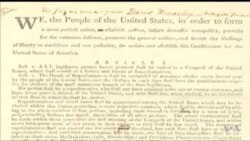ໃນແຕ່ລະປີ, ຫໍເກັບມ້ຽນເອກະສານແຫ່ງຊາດ ຈະຈັດງານຕ່າງໆ ເພື່ອສະເຫຼີມສະຫຼອງ
ວັນທີ 4 ກໍລະກົດ, ເຊິ່ງເປັນວັນກຳເໜີດຂອງ ສະຫະລັດ ອາເມຣິກາ. ສຳລັບປີນີ້, ຫໍເກັບ
ມ້ຽນເອກະສານທີ່ວ່ານີ້ ໄດ້ກະກຽມ ຈັດງານວາງສະແດງທີ່ເໝາະສົມກັບວັນດັ່ງກ່າວ.
ຊື່ຂອງງານ “ການແກ້ໄຂດັດແປງ ອາເມຣິກາ” ແມ່ນເລື່ອງ ກ່ຽວກັບ ຄວາມພະຍາຍາມ
ທີ່ຈະປ່ຽນ ລັດຖະທຳມະນູນ ສະຫະລັດ ທີ່ໄດ້ຮັບຄວາມລົ້ມແຫຼວຫຼາຍພັນຄັ້ງ, ເປັນກົດ
ລະບຽບພື້ນຖານ ແລະ ບັນທັດຖານ ທີ່ມີຄວາມກະທັດຮັດ ທີ່ ໄດ້ປົກຄອງ ອາເມຣິກາມາ.
ເມື່ອບໍ່ດົນມານີ້ ນັກຂ່າວວີໂອເອ Nikoleta Illic ໄດ້ພົບກັບຜູ້ເບິ່ງແຍງຫໍເກັບມ້ຽນເອກະ
ສານແຫ່ງຊາດດັ່ງກ່າວ, ນາງ Christine Blackerby ເຊິ່ງວ່າເລື່ອງລາວຈະເປັນແນວ
ໃດນັ້ນ, ພຸດທະສອນ ຈະນຳລາຍລະອຽດມາສະເໜີທ່ານ.
ລັດຖະທຳມະນູນ ຂອງສະຫະລັດ ລວບລວມເອົາຄວາມຄິດທີ່ລຽບງ່າຍ ແລະເອື້ອມໄປ
ໄກໄວ້ ທີ່ຮັບຮູ້ກັນວ່າ ສິດທິຂອງປະຊາຊົນແມ່ນຖືກມອບໃຫ້ໂດຍກົງໂດຍຜູ້ໃຫ້ກຳເນີດ
ບໍ່ແມ່ນໂດຍລັດຖະບານ ແລ້ວ ຫຼັງຈາກນັ້ນ ກໍມີພຽງແຕ່ປະຊາຊົນເທົ່ານັ້ນ ທີ່ເປັນຜູ້ມອບ
ສິດໃຫ້ລັດຖະບານ. ບໍ່ມີອັນໃດທີ່ເຄີຍເປັນແນວນີ້ມາກ່ອນ.
ຜູ້ກໍ່ຕັ້ງ ອາເມຣິກາ ເຊື່ອວ່າ ລັດຖະບານທີ່ຖືກສ້າງຂຶ້ນມາຈາກປະຊາຊົນທີ່ມີຄວາມຂາດ
ຕົກບົກຜ່ອງ ໃຊ້ອຳນາດຕໍ່ປະຊາຊົນທີ່ມີຄວາມຂາດຕົກບົກຜ່ອງ ຄວນມີອຳນາດຈຳກັດ. ລັດຖະທຳມະນູນທີ່ມອບໃຫ້ແກ່ລັດຖະບານ ນັ້ນເປັນພຽງແຕ່ສິດທິ ທີ່ປະຊາຊົນຢາກໃຫ້
ມີ. ທ່ານນາງ Christine Blackerby ຜູ້ເບິ່ງແຍງຫໍເກັບມ້ຽນເອກະສານແຫ່ງຊາດກ່າວ
ວ່າ ໃນຫຼາຍປີຜ່ານມາ, ລັດຖະທຳມະນູນຍາວ 8 ໜ້າ ຂອງ ສະຫະລັດ ແມ່ນໄດ້ຖືກສະ
ເໜີເພື່ອແກ້ໄຂນັບເປັນຈຳນວນຫຼາຍຄັ້ງ. ທ່ານນາງ Christine Blackerby ກ່າວວ່າ
“ມັນເຄີຍມີຂໍ້ສະເໜີ ເພື່ອແກ້ໄຂລັດຖະທຳມະນູນ ໃນລັດຖະສະພາປະມານ 11,000 ຄັ້ງ.
ເປັນຂໍ້ແກ້ໄຂທີ່ໄດ້ຖືກສະເໜີຂຶ້ນ ເມື່ອສະມາຊິກລັດຖະສະພາໄດ້ສະເໜີມັນຕໍ່ສະພາຕໍ່າ
ຫຼືບໍ່ກໍ ສະພາສູງ.”
ຄວາມພະຍາຍາມທີ່ຈະປ່ຽນແປງລັດຖະທຳມະນູນ ໄດ້ເລີ່ມຂຶ້ນເກືອບວ່າຈາກຕອນທີ່ມັນ
ໄດ້ເລີ່ມຖືກບັງຄັບໃຊ້ໃນປີ 1789. ກົດໝາຍ ກ່ຽວກັບ ສິດທິ, ເຊິ່ງມີການແກ້ໄຂ 10 ຢ່າງ
ທີ່ຈັດຂໍ້ຫ້າມສະເພາະເຈາະຈົງ 10 ຂໍ້ ກ່ຽວກັບ ອຳນາດຂອງລັດຖະບານນັ້ນ, ໄດ້ຖືກຮອງ
ຮັບໃນປີ 1791.
ທ່ານນາງ Christine Blackerby ກ່າວວ່າ “ມັນມີ ເຫດຜົນສາມຢ່າງໃຫຍ່ໆ ຫຼື ແນວຄິດ
ໃຫຍ່ທີ່ໄດ້ກໍ່ໃຫ້ເກີດການແກ້ໄຂລັດຖະທຳມະນູນ. ສ່ວນໃຫຍ່, ແທ້ຈິງແລ້ວພວກເຮົາ 17
ຈາກ 27 ທ່ານ ໄດ້ໃຫ້ສັດຕະຍາບັນການແກ້ໄຂທີ່ໄດ້ຂະຫຍາຍສິດທິຕ່າງໆ ລວມທັງ ສິດ
ທິໃນການລົງຄະແນນສຽງ, ສິດເສລີພາບໃນການປາກເວົ້າ, ຫຼື ສິດເສລີພາບໃນການປະ
ຕິບັດສາສະໜາ ແລະ ອື່ນໆອີກ.”
ທ່ານນາງ Blackerbyກ່າວວ່າ ຫົວຂໍ້ອື່ນໆທີ່ກຳລັງດຳເນີນຢູ່ກໍແມ່ນການກຳນົດອຳນາດ
ຂອງລັດຖະບານ.
ທ່ານນາງ Christine Blackerby ກ່າວວ່າ “ຍົກຕົວຢ່າງກໍຄືວ່າ, ພວກເຮົາໄດ້ຈຳກັດປະທານາທິບໍດີ ສະຫະລັດ ໃຫ້ດຳລົງຕຳແໜ່ງຢູ່ໄດ້ແຕ່ສອງສະໄໝ.”
ມັນມີຂໍ້ສະເໜີອື່ນໆອີກ ເຊັ່ນການເລືອກເອົາປະທານາທິບໍດີດ້ວຍການຈັບສະຫຼາກ, ຫຼື
ໃຫ້ລົບລ້າງລະບົບຄະນະປ່ອນບັດຂອງລັດ ຫຼື Electoral College, ພ້ອມກັບວາງລະ
ບຽບ ກ່ຽວກັບ ການແຕ່ງງານ, ການຍົກຍ້າຍຖິ່ນຂອງພວກນົກ ແລະ ການດື່ມເຫຼົ້າ ເປັນ
ຕົ້ນ.
ນອກນັ້ນ ກໍຍັງມີໄລຍະຂອງການເຄື່ອນໄຫວແກ້ໄຂທີ່ມີຄວາມເຄັ່ງຕຶງ, ສ່ວນໃຫຍ່ໃນລະ
ຫວ່າງ ເວລາຂອງການປ່ຽນແປງທາງສັງຄົມ.
ຂໍ້ສະເໜີການແກ້ໄຂລັດຖະທຳມະນູນຈຳນວນຫຼາຍທີ່ສຸດ ແມ່ນ ກ່ຽວກັບ ການແກ້ໄຂ ສິດ
ທິເທົ່າທຽມກັນ ທີ່ຖືກຮອງຮັບ ໂດຍລັດຖະສະພາ ແຕ່ບໍ່ແມ່ນໂດຍທຸກລັດ ໃນ ສະຫະລັດ.
ທ່ານນາງ Blackerby ກ່າວວ່າ ບໍ່ມີຂໍ້ສະເໜີໃດໆ ເຊິ່ງມີຂຶ້ນມາພາຍຫຼັງ 1,100 ສະບັບ
ເພື່ອລວມມັນເຂົ້າມາໃນລັດຖະທຳມະນູນ ທີ່ເຄີຍໄດ້ຜົນ.
ທ່ານນາງ Christine Blackerby ກ່າວວ່າ “ສາມສ່ວນສີ່ຂອງລັດຕ່າງໆ ຕ້ອງໃຫ້ສັດຕະ
ຍາບັນມັນ. ດັ່ງນັ້ນ, ເຖິງແມ່ນວ່າ ການແກ້ໄຂສິດທິເທົ່າທຽມກັນ ຈະຖືກຮັບຮອງເອົາໃນລັດຖະສະພາ ດ້ວຍຄະແນນສຽງ 2 ສ່ວນ 3 ກໍຕາມ, ມັນກໍຈະບໍ່ໄດ້ຮັບສັດຕະຍາບັນໂດຍ
ລັດຕ່າງໆ, ແລະ ມັນກໍຈະບໍ່ແມ່ນພາກສ່ວນນຶ່ງຂອງລັດຖະທຳມະນູນ.”
ປະຫວັດສາດໄດ້ພິສູດໃຫ້ເຫັນວ່າ ມັນຍາກຫຼາຍ ທີ່ຈະທຳການປ່ຽນແປງລັດຖະທຳມະ
ນູນ, ເຊິ່ງທ່ານນາງ Blackerby ກ່າວວ່າ ມັນແມ່ນ “ສິ່ງທີ່ດີ.”
ຄົນ ອາເມຣິກັນ ລຸ້ນກ່ອນໆໄດ້ອຸທິດຊີວິດຂອງພວກເຂົາເຈົ້າ ເພື່ອຈຸດປະສົງ ກ່ຽວກັບ ເສ
ລີພາບຂອງແຕ່ລະຄົນ ແລະ ຈຳກັດລັດຖະບານ, ໂດຍເຕືອນວ່າ ເສລີພາບ ຄວນຖືກຮັກ
ສາໄວ້ຢ່າງລະມັດລະວັງ ເພື່ອຄົົນລຸ້ນຫຼັງ.
((INTRO))
[[Each year, the National Archives organizes events marking the Fourth of July, the birthday of the United States of America. This year, the National Archives prepared an especially fitting exhibition.Entitled "Amending America," it is a story about thousands of failed attempts to change the U.S. Constitution, a succinct body of fundamental principles and precedents by which America is governed. VOA's Nikoleta Ilic recently caught up with National Archives curator, Christine Blackerby.]]
((NARRATOR))
The United States Constitution embodies a simple, far-reaching concept: recognizing that people's rights are granted directly by the creatornot by the stateand people only then grant rights to the government. Nothing like it had been done before.
America's founders believed that a government made up of imperfect people exercising power over other imperfect people should possess limited powers. The Constitution delegates to government only those rights the people want it to have. Through the years, the eight-page-long U.S. Constitution has been exposed to numerous proposals to amend it, says National Archives curator Christine Blackerby.
((CHRISTINE BLACKERBY, NATIONAL ARCHIVES))
"There have been about 11,000 proposals in Congress for constitutional amendments. An amendment is proposed when a member of Congress introduces it either in the House (of Representatives) or Senate."
((NARRATOR))
Attempts to change the Constitution began almost from the moment it came into force in 1789. The Bill of Rights, 10 amendments listing 10 specific prohibitions on governmental power, was adopted in 1791.
((CHRISTINE BLACKERBY, NATIONAL ARCHIVES))
"There were three main reasons or big ideas that have resulted in constitutional amendments. Most, in fact 17 of our 27, have been ratified amendments that have expanded rights, including voting rights, freedom of speech, or free exercise of religion and many others."
(NARRATOR))
Another continuing theme, says Blackerby, is regulating the power of government.
((CHRISTINE BLACKERBY, NATIONAL ARCHIVES))
"So, for example, we have limited the president of the U.S. to two terms."
((NARRATOR))
There were other proposals such as choosing presidents by lottery, or to abolish the Electoral College, as well as regulate marriage, migratory birds, and drinking alcohol.
There were also periods of intense amending activity, mostly during times of social change.
The biggest number of proposed amendments is related to the Equal Rights Amendment adopted by Congress but not by all U.S. states.
None of the subsequent 1,100 proposals to incorporate it into the Constitution worked, says Blackerby.
((CHRISTINE BLACKERBY, NATIONAL ARCHIVES))
"Three-quarters of the states have to ratify it. So, although the Equal Rights Amendment passed in Congress, with a two-thirds vote, it failed to be ratified by the states, and it is not part of the Constitution."
((NARRATOR))
History has proven that it is hard to make a constitutional change, which Blackerby says is "a good thing."
Early generations of Americans pledged their lives to the cause of individual freedom and limited government, warning that vigilance would be required to preserve freedom for posterity.





